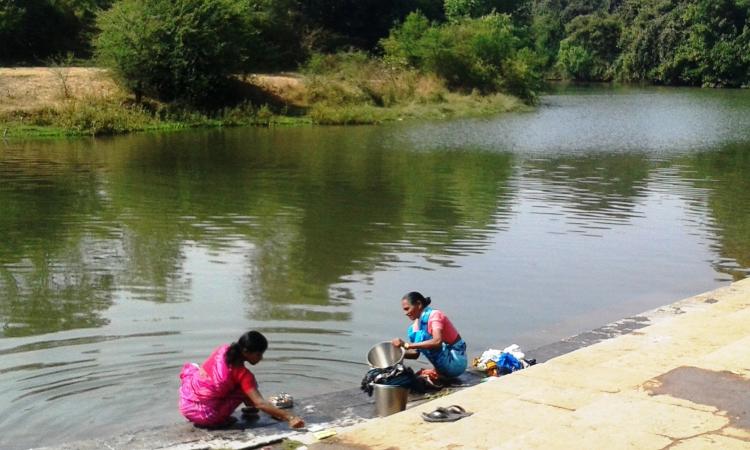
Growth and development indicators at the policy level many a times demand the need for factual data that is often standardised and expressed as numbers in order to make each local context comparable to other and allow data to be aggregated to higher geographical scales. This is also true of the field of gender and water where the need for gender disaggregated data is identified as very crucial and urgent making the generation of numbers seem like one of the important priorities.
Generating gender disaagregated data, looking beyond numbers
The paper titled 'Counting (gendered) water use at home: Feminist approaches in practice' published in the ACME: An International E-Journal for Critical Geographies argues that however, most of this kind of data that is discussed at national conferences does not give consideration to scale and many a times misses out on engaging with complexities produced by gender relations that are shaped by local contexts, specific cultures or the practicalities of data collection that seek to divide water use to different sectors, and reduce it to male and female populations.
Many a time, this kind of water use data is collected by technical experts who often do not touch upon the sacred domain of the household, and the household is consistently referred to as a single unit. However, feminist research has questioned this traditional view that individuals within the household share the same preferences, share in household chores, or pool in their resources. It has demonstrated that the rights, resources and responsibilities of household members, especially men and women, may be different.
The paper argues that this need for making quantitative data gender disaggregated seems to be particularly pronounced in what is seen by policymakers as “the water and sanitation sector.” However, it is important that for gender-disaggregated data to be meaningful, it has to be considered in the context of specific geographic scales, such as global, regional, national, or smaller political units of administration. In order to understand gendered water use, the tools must be consistent with broad feminist goals and ideologies, and be rooted in feminist insights gained through years of research and activism on gender equality. Translating feminist insights into operational tools should also include asking questions concerning context, authorship, and intent, such as “Who is conducting the research?”, “What is the ultimate goal of the project?” and “Where does it take place?”
These questions can be helpful in looking beyond numbers to understanding them in some context, and can prevent the reduction of the complex world of power and resource inequities into simplistic perceptions of the world as wholly comprehensible in terms of geography by numbers.
Tools for generating gender disaggregated data
The paper describes the examples of two recent tools developed in the gender and water sector to generate gender disaggregated data, The Water Diary and the Gender Equity Gauge both developed and used in two widely differing contexts namley urban Australia and rural India and Nepal. Through these two examples, the paper illustrates that the practical, participatory and transformative elements of these tools not only generate numbers but also address feminist concerns over methods used for collecting information.
The Water Diary (WD)
The tool 'The Water Diary' is simple where participants volunteer to keep a record of all theirs and their guests’ water uses at home for seven days in a hardcover WD booklet. This includes details of the purpose the water was used for, the time of the activity, who used the water, and the amount of water used. The diary approach also gathers qualitative data about household water use practices and water chore performance through a questionnaire or an interview. The booklet also contains a questionnaire, which provides household characteristics and qualitative insights into the water use data.
Gender Equity Gauge (GEG)
The main purpose of the GEG was to develop and demonstrate a tool that can capture the social and gender inequities in the uses of water in rural homes in South Asia to establish the relation between water and equity and map access to quality and quantity of water by different social groups. The GEG was first tried out in 2011 in Nepal and India, and analysis of the primary and secondary data was undertaken at the Society for Promoting Participative Eco-system Management (SOPPECOM).
The critical issues examined by the GEG were on who has control over water and who makes decisions around its use. This involved exploration of three issues namely, access to water, the specific chores and activities around water and participation in decision-making and/or planning processes related to water.
Reflections on the tools
It was found that the GEG was marked by more freedom of inquiry and created space for the integration of insights into the different realities of socially diverse groups of people enabling a broader, shared understanding of a complex social context.
The Water Diary was however, more participatory and led to an overall increase in the awareness of the participants’ personal sense of the absolute amounts of water use, encouraged reflection of water wastages, and resulted in some changes in water use behaviour.
The findings
An analysis of these tools found that regardless of the disparities and failings of the two approaches, these studies--when considered together--created new spaces in which traditional research tools could function. Thus interviews and diarised records generated knowledge on a little-known area of women’s and men’s lives. The paper ends by arguing that in thinking about water use by women and men at home, it is important to explore how to represent the gendered worlds and experiences of those who comprise what until recently has been the unquestioned atomistic unit of understanding--the household.
Please download a copy of the paper below.
/articles/gender-and-water-use-looking-beyond-pure-data